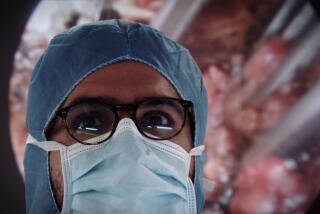Surgery’s about to begin, but a terrified patient is still ‘Awake’
- Share via
“Awake,” Weinstein Co., GreeneStreet Films, filmed at New York’s Bellevue Hospital Center, release date Nov. 30.
The premise: Business mogul Clayton Beresford Jr. (Hayden Christensen) had a massive heart attack and was treated at the local city hospital by cardiovascular surgeon Jack Harper (Terrence Howard). As Beresford’s heart continues to weaken, he chooses Harper to perform his heart transplant.
But Harper and Beresford’s fiancee and then wife, Samantha Lockwood (Jessica Alba), are plotting to kill him -- and they intentionally choose an anesthesiologist with a drinking problem, Dr. Larry Lupin (Christopher McDonald), to deliver anesthetic during Beresford’s surgery.
Beresford receives intravenous as well as mask anesthesia, but he never goes to sleep. Although his muscles are paralyzed, he continues to experience terrible pain and full awareness throughout the operation, as well as hallucinations and out-of-body experiences. He wishes he could scream for help.
In one scene, he experiences himself rising up from the operating room table and pulling out all his lines and tubes -- only to discover, a moment later, that he never really moved.
According to the film, 30,000 people experience so-called anesthesia awareness every year in the U.S., out of 21 million cases of general anesthesia.
Medical questions: Is anesthesia awareness as common as the film suggests? Is it believable that someone experiencing it could be awake from beginning to end of an operation? Are there signs of such awareness that an astute anesthesiologist would recognize and counter during the course of an operation? How common are out-of-body experiences during anesthesia awareness?
The reality: Nineteenth century French physiologist Claude Bernard famously described awareness after muscular paralysis (induced by administering the drug curare) as finding oneself “fully alive, entombed in a corpse.” Of course, awareness might be expected in Bernard’s days when patients received only paralytics, but it is hardly supposed to happen today when we render patients fully unconscious.
According to Peter Sebel, vice chairman of anesthesiology at Emory University in Atlanta and author of a definitive study on the subject published in 2004 in the journal Anesthesia & Analgesia, the film is correct about how common the condition of anesthesia awareness is -- it occurs in about 0.14% of cases.
But Dr. Johnathan Pregler, professor of anesthesiology at UCLA and director of the UCLA Surgery Center, says this figure includes “any kind of recollection,” and that fully awake patients experiencing pain are by far the exception rather than the rule.
Both experts say they’ve never heard of a case of continuous recollection from before the induction of anesthesia until the end of the operation. “That just doesn’t happen,” Sebel says.
General anesthesia usually involves premedication with a sedative such as Versed, then induction of sleep with a medication called Propofol, followed by an inhaled anesthetic. All of these chemicals cause amnesia, but not to the same degree in all patients.
Because the drugs may suppress functioning of the heart, they are sometimes used in lower doses during cardiac surgery, thereby increasing the risk of anesthesia awareness.
Those undergoing heart surgery (or any procedure in which the surgeon needs access to body cavities or needs the patient to be absolutely still, such as for microsurgery) are also given drugs to paralyze their muscles.
Dr. Jeffrey Lee, director of obstetric anesthesia at Los Angeles County-USC Medical Center, says that liberal doses of neuromuscular paralytics such as rocuronium relax the muscles during the process of opening the chest and working on the heart. In other words, waking up in the operating room unable to move or speak is possible.
Still, in contrast to the movie’s rendition, Sebel says that in the real world experiencing pain is very unusual during cardiac surgery because of the relatively high doses of opiates -- morphine or fentanyl -- that the patient also receives.
In researching cases for his 2004 review, Sebel was struck by the lack of changes in heart rate or blood pressure of patients who were aware -- so if a patient does wake up, it may not be easy to spot.
Recognition should be easier when a patient is also in pain, Pregler says, because there are usually changes in vital signs (such as increased heart rate and blood pressure as well as sweating, pupil dilation and tear-formation) that would be noticed by any competent anesthesiologist. (These may be missed by the film’s Dr. Lupin because he is intoxicated during the surgery.)
Out-of-body experiences are unlikely with today’s anesthetics, but there is a 6% rate of dreaming during anesthesia, Sebel says.
Recent studies have shown that anesthesia awareness can be reduced by 80% in high-risk patients -- those undergoing cardiac, obstetric or major trauma surgeries -- through the use of electroencephalography (EEG) to monitor brain activity during surgery: If EEG readings show that a patient is waking up, he or she can be given more anesthetic. These brain monitors are present in 60% of U.S. operating rooms.
Sebel is concerned that the movie will create unnecessary panic, and he stresses again that anesthesia awareness is comparatively rare and anesthesia is generally safe.
“People should not be frightened about having an anesthetic,” he says. “It is probably much safer than driving on an L.A. freeway.”
--
Dr. Marc Siegel is an internist and an associate professor of medicine at New York University’s School of Medicine. He is also the author of “False Alarm: The Truth About the Epidemic of Fear.” In The Unreal World, he explains the medical facts behind the media fiction. He can be reached at marc@doctorsiegel.com.


